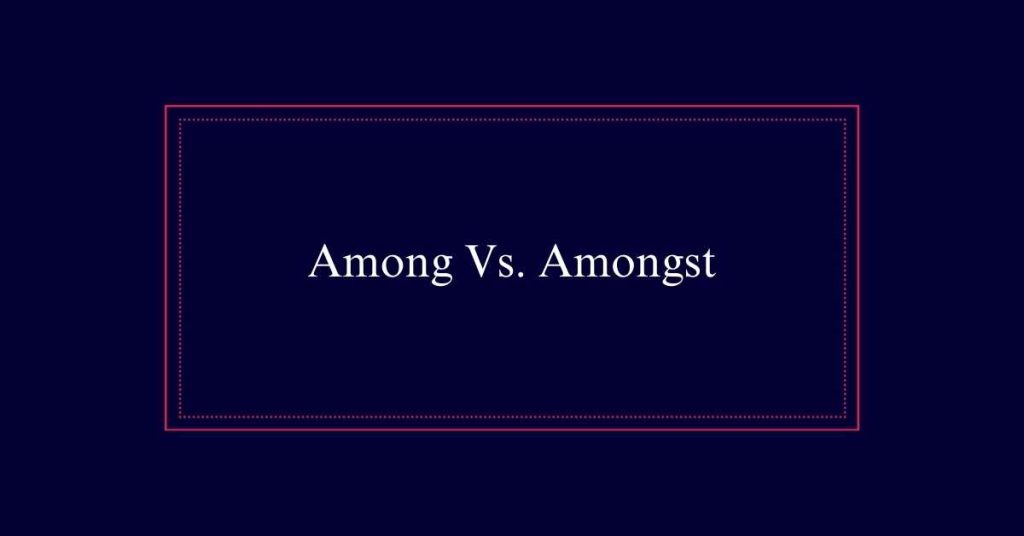Among Vs. Amongst
‘Among’ and ‘amongst’ are prepositions with the same meaning, both indicating being part of or in the midst of a group. ‘Among’ is significantly more common, especially in American English, and is recommended for simplicity and clarity. ‘Amongst’ is less frequently used and tends to add a more formal or traditional tone, particularly in British English. While some may consider ‘amongst’ old-fashioned or pretentious, it remains grammatically accurate.
Historical Background
Tracing the origins of ‘among’ and ‘amongst’ reveals a rich historical background rooted in Old and Middle English.
Among’ dates back to Old English, where it appeared as ‘gemang,’ meaning ‘in a crowd’ or ‘mingled with.’ Over time, it evolved into the more familiar form we use today.
‘Amongst,’ on the other hand, emerged during the Middle English period. It was influenced by the addition of the suffix ‘-st,’ which was common in several words of that era. This suffix made the word slightly more formal.
Definitions and Usage
Among and amongst are prepositions that share the same meaning but differ in usage frequency and context. Both words denote being in the midst of, surrounded by, or part of a group. For example, ‘The secret was hidden among the books’ and ‘The secret was hidden amongst the books’ mean the same.
‘Among’ is more commonly used, especially in American English. It is considered the standard form for modern writing. ‘Amongst’ is less frequent and often seen in British English or literary contexts. Despite its rarity, ‘amongst’ is not incorrect. It can add a formal or old-fashioned tone.
Popularity in Writing
While both ‘among’ and ‘amongst’ are correct, ‘among’ is much more common in modern writing, especially in American English. This preference is evident in various forms of literature, journalism, and academic texts. ‘Among’ appears notably more frequently than ‘amongst,’ making it the go-to choice for writers aiming for clarity and simplicity.
In contrast, ‘amongst’ is seen less often and can come across as archaic or overly formal. Despite this, it is not incorrect. Some writers may choose ‘amongst’ for stylistic reasons or to evoke a particular tone.
However, for most contemporary writing, especially in the U.S., ‘among’ is recommended for its straightforwardness and broad acceptance.

American Vs. British Usage
The usage of ‘among’ and ‘amongst’ varies between American and British English. In American English, ‘among’ is overwhelmingly preferred, while ‘amongst’ is rarely used. Conversely, British English displays a more balanced usage, though ‘among’ remains more common. Here is a comparison:
| Feature | American English | British English |
|---|---|---|
| Common Usage | Among | Among |
| Less Common Usage | Amongst | Amongst |
| Formality | Among (less formal) | Amongst (more formal) |
| Frequency in Writing | Very frequent | Frequent |
| Perception | Modern | Traditional |
Literary Examples
Notable authors have often employed ‘amongst’ in their works to add a touch of traditional elegance to their prose. For example, J.K. Rowling uses ‘amongst’ in her Harry Potter series, lending a classic feel to the narrative.
Oscar Wilde also favored ‘amongst,’ as seen in his play ‘The Importance of Being Earnest,’ which contributes to the play’s refined tone.
The Roman philosopher Marcus Tullius Cicero’s translated works include ‘amongst,’ which enhances their scholarly appeal.
Even contemporary playwright Jane Wagner has used ‘amongst,’ demonstrating its timeless charm.
Modern English Comparisons
Comparing modern usage of ‘among’ and ‘amongst’ highlights their differing frequencies and stylistic implications in contemporary English. ‘Among’ is overwhelmingly more common, particularly in American English. ‘Amongst,’ while still correct, is less frequently used and may carry a more formal or old-fashioned tone.
Here is a comparison of usage:
| Aspect | Among | Amongst |
|---|---|---|
| Frequency | Very High | Low |
| Common Usage | American English | British English |
| Tone | Neutral, everyday use | Formal, old-fashioned |
Misconceptions and Myths
Despite their interchangeable meanings, several misconceptions surround the use of ‘among’ and ‘amongst.’ One common myth is that ‘amongst’ is archaic or pretentious. In reality, both forms are correct and accepted in modern English. Some people believe ‘amongst’ is more formal than ‘among,’ but this is not supported by linguistic experts.
Another misconception is that ‘amongst’ is used exclusively in British English. While it is true that ‘among’ is more prevalent in American English, ‘amongst’ is still used and understood.
Lastly, some think ‘amongst’ should be avoided altogether. However, using either word is a matter of personal style and preference, without impacting grammatical correctness.
Distinctions With ‘Between’
Understanding the distinctions between ‘among’ and ‘between’ is essential for accurate and effective communication.
Use ‘among’ for relationships within a collective group. For example, ‘She was well-respected among her peers’ signifies respect within a group.
On the other hand, ‘between’ is used for one-to-one or binary relationships. For instance, ‘The agreement was made between the two companies’ indicates a relationship involving two entities.
‘Between’ can also apply to more than two items if the relationship is individual and distinct, such as ‘The negotiations between the three parties were complex.’
Expert Opinions
Language experts often emphasize that both ‘among’ and ‘amongst’ are grammatically correct and interchangeable.
According to linguists, the choice between the two depends largely on regional preferences and stylistic considerations. ‘Among’ is more commonly used, especially in American English, due to its simplicity and modern feel. Conversely, ‘amongst’ is more prevalent in British English and can lend a traditional or formal tone to writing.
Experts note that neither word is superior to the other; their usage should align with the writer’s audience and context. The consensus among linguists is that both terms are equally valid, reinforcing the flexibility and richness of the English language.







